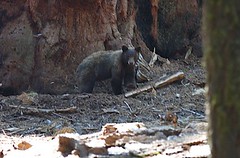Devra G. Kleiman dies at 67; helped create field of conservation biology
Washington Post Staff Writer
Tuesday, May 4, 2010
In a career spanning more than 40 years, much of it at the National Zoo, Dr. Devra G. Kleiman helped create and define the new field of conservation biology.
She was perhaps best known for spearheading an unprecedented international effort to save golden lion tamarins -- small, reddish-orange monkeys that live in Brazil's Atlantic coastal forests -- from extinction.
In the early 1970s, Dr. Kleiman responded to an alarm sounded by Brazilian biologist Adelmar Coimbra Filho. Golden lion tamarins were in trouble; research showed there were only several hundred of the animals remaining in the wild and fewer than 75 in captivity. Dr. Kleiman and Coimbra helped persuade officials at more than a dozen zoos not to sell their golden lion tamarins for profit. Instead, the zoos would lend the animals to one another for breeding. Eventually they gave up title altogether, ceding ownership to the Brazilian government. Dr. Kleiman played monkey matchmaker, using genetic data to determine which animals should mate to create strong offspring.
Those offspring were reintroduced to Brazil, where Dr. Kleiman and Coimbra helped preserve and restore wide swaths of the animals' habitat. Today, about 1,600 golden lion tamarins live in the wild. Another 500 live in 145 zoos around the world. The species' status has been changed from critically endangered to endangered, and a Brazilian organization that Dr. Kleiman helped found is coordinating efforts to ensure the species' long-term survival.
Dr. Kleiman's effort was "one of the greatest success stories in the history of modern zoos," said Steven Monfort, director of the Smithsonian Conservation Biology Institute. "It was the beginning of this revolution of the role of zoos as conservation organizations, instead of just having a place for exhibiting specimens for people to come look at and enjoy."
The cooperative model Dr. Kleiman pioneered with the golden lion tamarin project has since been widely adopted as the most effective way to manage the genetics of rare species. It has been crucial to the successful reintroduction to the wild of species including the black-footed ferret and the California condor.
At the same time that she was working with golden lion tamarins, Dr. Kleiman was making headlines for her efforts to breed the National Zoo's first pair of giant pandas.
Ling-Ling and Hsing-Hsing were gifts from China, arriving at the zoo in 1972. Almost no rigorous research had been conducted on pandas and little was known about their behavior.
Conventional wisdom held that pandas are solitary creatures, so Dr. Kleiman and her colleagues kept Ling-Ling and Hsing-Hsing apart except for brief annual mating periods. Their enclosure was spartan, a plain yard with one climbing platform. They ate a simple diet of rice gruel and milk.
The pandas' reproductive results, carefully tracked by the national media, were heartbreaking. Between 1983 and 1989, Ling-Ling became pregnant four times. One baby was stillborn; the others died within hours or days of their birth.
During the roller coasters of those pregnancies, Dr. Kleiman led a team of scientists who used cameras and trained volunteers to track the animals' behaviors. They wrote some of the first descriptions of pandas' vocalizations, their play, their scent markings and their deportment during mating. They concluded that pandas were social creatures who needed to interact.
"As I think back to what we didn't know in 1972, it was just about everything," Dr. Kleiman told The Washington Post in 2001. "We were flying blind."
When the National Zoo's second pair of pandas arrived in 2001, they dined on bamboo, carrots and apples, and they were allowed to play together in a large enclosure studded with sand wallows, ponds and trees. In 2005, the couple successfully produced Tai Shan, the first panda born at the National Zoo to survive longer than a few days.
"We've gone way beyond where we were," Monfort said, "and Devra set the benchmark."
'Hooked' on pandas
Devra Gail Kleiman was born Nov. 15, 1942, in the Bronx, N.Y. She graduated from the University of Chicago in 1964. As an undergraduate, she raised a baby dingo in her apartment one summer and took a part-time job as an assistant on a research project to tame wolves.
She spent hours in their cages doing crossword puzzles and homework assignments. The experience helped persuade her to forgo a career in medicine and study animal behavior instead.
She received her doctorate in zoology from the University of London in 1969. After being turned down for one job because "there weren't enough women's toilets," she once said, she became one of the National Zoo's first female scientists in 1972.
She became head of the Department of Zoological Research in 1979 and the zoo's assistant research director in 1986. She wrote and edited several books, including "Wild Mammals in Captivity," an animal-husbandry handbook and "Lion Tamarins: Biology and Conservation."
After retiring in 2001, she continued to work on a number of conservation projects and was an adjunct professor of biology at the University of Maryland, a position she had held since 1979. She enjoyed spending time at her vacation home in Chincoteague, Va.
Her first marriage, to John F. Eisenberg, ended in divorce.
Survivors include her husband of 22 years, Ian Yeomans of Chevy Chase; three stepdaughters, Elise Edie of Ellensburg, Wash., Joanna Domes of Calgary, Alberta, and Lucy Yeomans of Manchester, England; her mother, Molly Kleiman of Silver Spring; a brother; and four grandchildren.
When the first pandas arrived at the National Zoo, Dr. Kleiman told The Post in 2001, she was uninterested in studying them. "I thought it was too political and too dominated by public relations," she said. "But I started sneaking in and doing observations on them early in the morning. I got hooked."















 My daughter and I just previewed (
My daughter and I just previewed (



